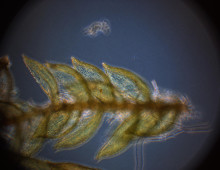Complex microbial communities provide benefits to host plants such as ability to grow on marginal lands, pathogen resistance, abiotic stress tolerance, and increase in biomass productivity. Populus has received attention in bioenergy research as a source of cellulose-derived biofuels and as a model tree species. Populus trees are host to a diverse microbial community that…
Sorghum GENCODE Project
The overall goal of the Sorghum GENCODE project is to obtain in-depth knowledge of key gene regulatory networks that will enable the design of high yielding feedstocks of the DOE JGI Flagship Plant sorghum and other C4 grasses that can be sustainably produced and efficiently converted by the U.S. biofuels industry. As part of this…
Characterizing BDLs in MycoCosm’s fungal genomes
Benzenediol lactones or BDLs are a subclass of polyketides whose known representatives show widely varied biological activities, including stress tolerance and other roles related to plant health and productivity. Through a novel technique dubbed “comparative metaparvomics,” this project uses genome sequence information from the fungal genomes in the DOE JGI portal MycoCosm and interpreted by…
A Brachypodium ENCODE-like project
The Brachypodium reference genome was sequenced, assembled and annotated by the DOE JGI. This project builds upon the reference genome by generating gene regulatory networks in Brachypodium in order to identify genes capable of conferring enhanced traits in bioenergy crop plants. In particular, the project will focus on generating fundamental systems-level information on drought tolerance and water…
Soybean and Sorghum root hair cell studies
The epigenome is comprised of chemical compounds that mark the genome with instructions such as what to do, and where and when to do it. A transcriptome is a collection of all the transcripts present in a given cell. When the epigenomic and transcriptomic responses of a cell to a stressor are recorded, they provide…
Characterizing airborne microbial communities
The abundance of microorganisms in the atmosphere has lead to the hypothesis that airborne cells play significant roles in atmospheric chemistry, the water cycle, and climate. Supporting this idea are several bacterial species known to serve as efficient ice nuclei based on an excreted protein that can initiate ice formation and participate in cloud formation…
Toward multi-gene pathway engineering in plants
Researchers have developed an exon orgenetic sequence that codes for protein synthesis and is derived from natural sequences found in plant genes. This exon technology allows for multi-parameter regulation of a gene of interest by any two promoters in plants. Two promoters, allowing the exon to perform what is known as “parallel promoter stacking”, can…
Continuing studies of Dothideomycetes fungi
Dothideomycete fungi are found in a wide range of environments and include both extremophiles and plant pathogens that pose a major threat to sustainable bioenergy production. One such fungus is Baudoinia compniacensis, which can survive temperatures over 50ºC after exposure to ethanol vapor. However, nothing is known about the genes induced by ethanol or how…
Moss-Cyanobacteria Interactions in Boreal Forest Ecosystems
As a global carbon sink, the health and productivity of this ecosystem is important to preventing future increases in carbon dioxide emissions.
Identifying Enzymes from Novel Anaerobic Gut Fungi
Biofuels derived from plant biomass avoid many of the economic and environmental problems that plague traditional energy sources. However, existing technologies are insufficient to allow for industrial-scale conversion of plant waste into simple sugars and resulting conversion into renewable fuels. Researchers expect to help mitigate this issue by studying how anaerobic gut fungi break down…
